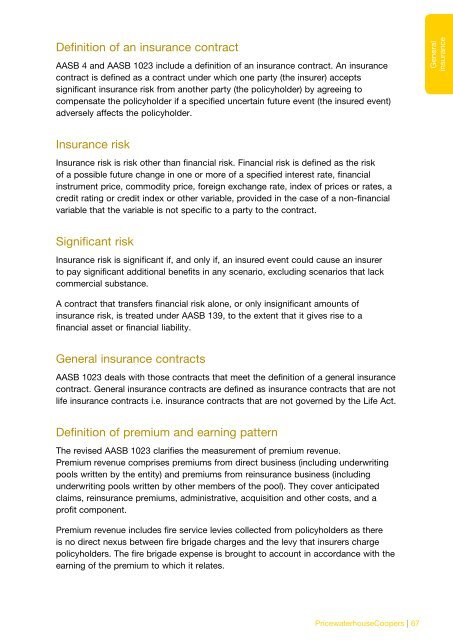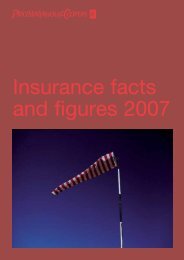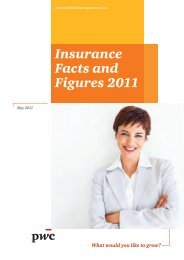Insurance - PricewaterhouseCoopers
Insurance - PricewaterhouseCoopers
Insurance - PricewaterhouseCoopers
Create successful ePaper yourself
Turn your PDF publications into a flip-book with our unique Google optimized e-Paper software.
Definition of an insurance contract<br />
AASB 4 and AASB 1023 include a definition of an insurance contract. An insurance<br />
contract is defined as a contract under which one party (the insurer) accepts<br />
significant insurance risk from another party (the policyholder) by agreeing to<br />
compensate the policyholder if a specified uncertain future event (the insured event)<br />
adversely affects the policyholder.<br />
<strong>Insurance</strong> risk<br />
<strong>Insurance</strong> risk is risk other than financial risk. Financial risk is defined as the risk<br />
of a possible future change in one or more of a specified interest rate, financial<br />
instrument price, commodity price, foreign exchange rate, index of prices or rates, a<br />
credit rating or credit index or other variable, provided in the case of a non-financial<br />
variable that the variable is not specific to a party to the contract.<br />
Significant risk<br />
<strong>Insurance</strong> risk is significant if, and only if, an insured event could cause an insurer<br />
to pay significant additional benefits in any scenario, excluding scenarios that lack<br />
commercial substance.<br />
A contract that transfers financial risk alone, or only insignificant amounts of<br />
insurance risk, is treated under AASB 139, to the extent that it gives rise to a<br />
financial asset or financial liability.<br />
General insurance contracts<br />
AASB 1023 deals with those contracts that meet the definition of a general insurance<br />
contract. General insurance contracts are defined as insurance contracts that are not<br />
life insurance contracts i.e. insurance contracts that are not governed by the Life Act.<br />
Definition of premium and earning pattern<br />
The revised AASB 1023 clarifies the measurement of premium revenue.<br />
Premium revenue comprises premiums from direct business (including underwriting<br />
pools written by the entity) and premiums from reinsurance business (including<br />
underwriting pools written by other members of the pool). They cover anticipated<br />
claims, reinsurance premiums, administrative, acquisition and other costs, and a<br />
profit component.<br />
Premium revenue includes fire service levies collected from policyholders as there<br />
is no direct nexus between fire brigade charges and the levy that insurers charge<br />
policyholders. The fire brigade expense is brought to account in accordance with the<br />
earning of the premium to which it relates.<br />
<strong>PricewaterhouseCoopers</strong> | 67<br />
General<br />
insurance

















